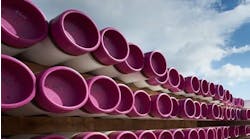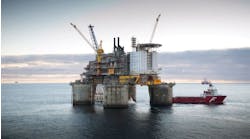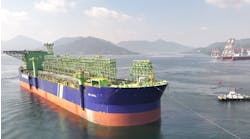Offshore staff
TOKYO, Japan — Kawasaki Heavy Industries has completed offshore verification tests with TotalEnergies using an AUV to measure the electrical potential of subsea pipelines.
The close-range inspections were performed offshore Awaji Island in Japan’s Hyogo Prefecture.
Kawasaki has been developing what it claims is the world’s first AUV with a robot arm for subsea pipeline inspections, named SPICE (Subsea Precise Inspector with Close Eyes).
The development follows increased demand for subsea pipeline maintenance in offshore oil and gas fields.
During a 2020 verification test, conducted under the “Joint Technological Development Support Program for Offshore Oil and Natural Gas Fields” of DeepStar and The Nippon Foundation Ocean Innovation Consortium, SPICE achieved stable pipe-tracking performance and proved its cability for close-range subsea pipeline inspections.
Kawasaki and TotalEnergies then committed to integrate TotalEnergies’ electrical potential measurement technology, Light Touch Cathodic Protection (LTCP), with SPICE. The goal was to adapt the AUV to measure electrical potential gradient of a pipeline, allowing the detection of potential coating defects.
Basic design finished in February 2021, and various integration simulations were performed. During August 2021, more detailed design and modifications of SPICE followed to incorporate the LTCP.
These paved the way for the verification test off Awaji Island from Aug. 30 through Sept. 2, 2022.
Simulated pipes and a corrosion protection system were placed on the seabed under the supervision of TotalEnergies. SPICE, using its pipe-tracking capability, undertook measurements of electrical potential using its autonomously controlled robot arm with the newly integrated measurement device to check the pipelines’ condition of protection against corrosion, as inferred by the measurement of the electrical potential.
Andy Gower, R&D Subsea Robotics Project Leader of Stavanger Research Centre at TotalEnergies, said, ”LTCP had demonstrated its repeatability of establishing the effectiveness of the cathodic protection system in a controlled test environment, and there was a need to deploy the technology in close proximity to the pipe under inspection.
“SPICE, with the ability to deploy sensors at a controlled distance, enabled LTCP to demonstrate repeatable performance. The potential for additional sensors to be deployed at the same time, should enable other non-destructive test sensors and techniques, providing enhanced data of aging pipeline and allowing integrity threats to be assessed with more detail.
“The future trend of subsea robotics is for highly maneuverable sensor platforms, and the performance of LTCP integrated with SPICE, provides an effective solution to determine the performance of the cathodic protection system in an operational context.”
Last year Modus Subsea Services placed an order for the first commercial model of SPICE, which will be an upgraded version of the system used for the trial offshore Japan.
01.17.2023



